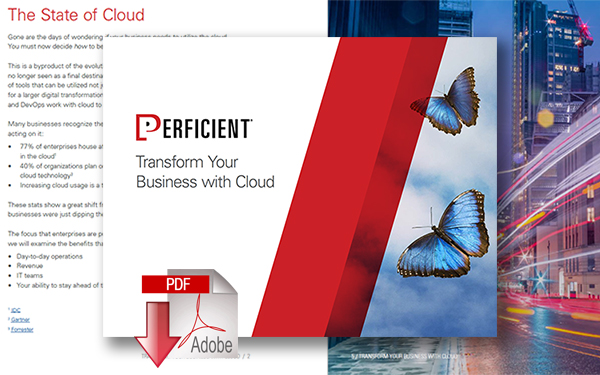Cloud Transformation
This is the next installment in a series of Perficient blogs on the subject of cloud transformation and specifically cloud migration.
We decided to call out this specific cloud lift-and-shift migration strategy because of our clients’ experience with this strategy.
Many of our clients have seen both negative and positive results from this strategy, however, all of them missed many of the items we have called out below.
As a result of missing some of these items, expectations by leadership and others within the organization have been skewed too far in both optimistic and negative ways.
It is fully recognized there are at least four other strategies for cloud migration: refactor, revise, rebuild, and replace.
Cloud Lift and Shift Definition
“Lift and shift” refers to an application migration (rehost) strategy for movement to a cloud-based environment.
Normally, this approach implies a little-to-no change in the application and data architecture.
Speed and cost are usually the focus when choosing this 'lift and shift' strategy.
Cloud Lift and Shift Things to Consider
- This strategy (like most migration strategies) still requires some planning upfront. Successfully running this application on traditional hardware servers or on-premises VMs doesn’t mean it will run correctly in the cloud.
- Be sure to do a deep dive on all connections in and out of the application and data.
- What is the expected life of this application and data? If the life span is shorter than 12 months, it might not be worth moving it to the cloud.
- Give careful consideration to the number and types of access required for this application and data. You need to conduct additional analysis to determine how to provide access to other APIs and/or data that are not included in the code and/or data being moved.
- Many cloud hosting providers will have automated tools for migrating these kinds of standalone applications and data. Examine the tools provided by your cloud hosting provider to determine the capability for your specific situation. These tools are often a quick way to run a “test” migration and work out the architectural kinks in the cloud.
- If you have more than one application that falls into a “lift-and-shift” category for migrating to the cloud, then it might make sense to write a runbook to automate multiple migrations in a batch-type operation.
- This type of migration strategy can be just a “first step” for a broader strategy. Many organizations will have multiple smaller applications and data that should be combined and refactored for native-cloud capabilities. It is often easier to perform the “refactoring” in the cloud when all the applications and data are already sitting in the same cloud location.
- You still need to test once the migration has occurred despite this strategy being simpler and faster. Make sure your current test suite can be executed against the application once it is in the cloud environment.
- All of the current application, data compliance, and regulatory requirements will remain the same once it is in the cloud environment. You should check all of these boxes when setting up the cloud environment. You can then run your normal validation testing once it is migrated.
- Like any other project, be sure scope creep is managed closely. It is so easy to turn on additional features in the cloud that might provide some benefit to the application. However, a functioning application may not need all of these features. The ease of this ability to turn something on can lead to many additional hours of testing to validate you have not created a new set of bugs.
Cloud Lift and Shift Summary
The items in the “Things to Consider” section above highlight that the lift-and-shift strategy can be more complicated than anticipated.
It is important with any kind of cloud migration to be sure you take the time to properly analyze and evaluate your applications and data.
This planning work upfront will save thousands of wasted hours due to improper migration strategy selection.
As part of any cloud transformation strategy, there must be a plan to evaluate your “complete” application and data portfolio.
This evaluation should be a multi-level review that segments your portfolio into well-defined categories.
Lift and shift (rehost) can be an extremely beneficial strategy for many applications. It also provides a great learning exercise for those first migrations to the cloud.
However, many applications will benefit both in the short term and the long term from the use of an alternative cloud migration strategy.
This is a case where one size DOES NOT fit all.
About the Author
Victor Wolters is an Enterprise Strategist at Perficient.
About Perficient
Perficient is the leading digital transformation consulting firm serving Global 2000® and enterprise customers throughout North America. With unparalleled information technology, management consulting, and creative capabilities, Perficient and it's Perficient Digital agency deliver vision, execution, and value with outstanding digital experience, business optimization, and industry solutions.
Related Article: Why Supply Chain Leaders Are Migrating to the Cloud
Download Related Paper
Transform Your Business with Cloud Technology New!
In this guide, we examine the benefits that the cloud will bring to; day-to-day operations, revenue, IT teams, and your ability to stay ahead of the curve – and your competitors. Download Now!
More “Cloud” Resources
Article topics
Email Sign Up



















